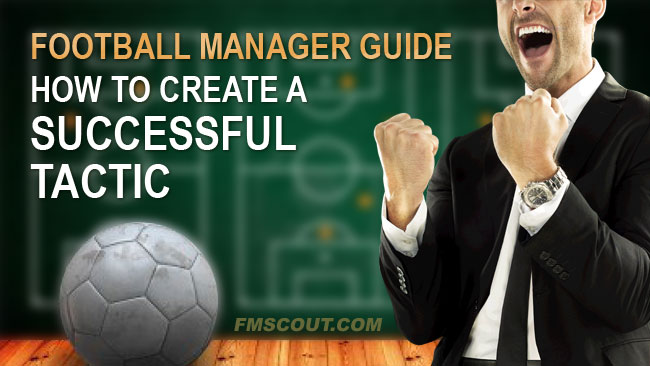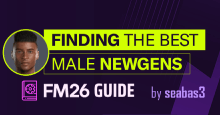
Team instructions
Written by Neal, RandydeB and JusticeHere we will have a look through each of the Team Instructions, and how they affect your team’s play.
General
MentalityThis is how your team approaches the game. Do you go ultra-defensive with ‘Contain’, setting out with the sole purpose of completely nullifying the opposition, or do you go ultra-attacking with ‘Overload’, and go all-out to score a goal? Of course, you can go somewhere in between, with ‘Standard’ offering equal emphasis in each aspect of the game. The vast majority of football managers will look to put slightly more emphasis on one side of the game to the other, whether that be in attack or in defence.
Playing with a ‘Control’ mentality allows your players to focus on their work on the ball, looking to progress in attack, while still being quite wary in defence. The emphasis will certainly be on attacking with the ball, looking to beat the opponent with focus that way, but your players will (should) be ready to put in a defensive shift if required.
Playing with a ‘Counter’ mentality allows your players to focus on their off the ball, holding firm in defence, while being very prepared to break in attack when the opportunity arises. If you expect to have less possession, this would perhaps be a very option as it sets your team up to focus on defending opposition pressure, and then attack when the opportunity arises.
The ‘Attacking’ mentality has a greater focus on attack than that of the ‘Control’ mentality, while showing considerably less of a defensive focus. The ‘Defensive’ mentality has a greater focus on defending than that of the ‘Counter’ mentality, while showing considerably less of an attacking focus.
Team Shape
This is how much you want your players to focus on the different phases of the game. Do you want your attackers to contribute to defending, or just focus purely on attacking? The two extremes are ‘Highly Structured’ and ‘Very Fluid’, while ‘Flexible’ offers a balanced in-between.
A ‘Highly Structured’ team will see your players focus on their individual phases of the game. Attackers will stick to attacking, and defenders will stick to defending. This is very useful if you want your players to highly contribute to certain aspects of a game, and remain in focus of a certain phase.
A ‘Very Fluid’ team will see your players contribute to all phases of the game. Attackers will help win the ball back in defensive work, while defenders will look to contribute to attacking moves. This promotes the ‘Total Football’ philosophy that was made famous by the Dutch national football team in the 1974 FIFA World Cup.
Tempo
How quickly do you want your team to play their game? Do you want your team to play with a ‘Lower’, or even a ‘Much Lower’, tempo, focusing on maintaining a patient approach throughout the ninety minutes? This would allow your team to play with greater measure, often looking to control the whole game, with no short-term goal in mind.
On the flip side, do you want your team to play with a ‘Higher’, or even a ‘Much Higher’ tempo, focusing on playing with purpose to unnerve the opposition? This would allow your team to move the ball around quickly in to dangerous areas, but risk more mistakes as your players would have to react much quicker in these circumstances.
If you’re unsure over which tempo you would prefer, you could always look to use a ‘Normal’ tempo, where your players look to speed up or slow down the tempo depending on the situation. This allows for greater flexibility of play, but also requires good decision making on your players’ behalf to decide when and where a fast/slow tempo is necessary.
Depending on the tempo of your team, you may also decide whether you wish your players to ‘Take A Breather’ when the opportunity arises. They will not press the ball or attack with great urgency, instead they will focus on regaining stamina and keeping the game at a nice, slow tempo. This is useful if your team is looking exhausted and just needs a break.
Time Wasting
This is a by-product of the mentality of your team. An attacking mentality would mean little, or no, use of time wasting, and so it is only available to change in more defensive mentalities. This is a method of killing any momentum the opposition may have.
Width
This impacts the shape of your team quite a bit. How wide, or how narrow do you wish your team to play? What areas of the pitch do you want to control?
A ‘Narrow’ width would usually be more suited to defensive mentalities, as it allows you to congest the middle areas of the pitch and force the opposition out wide when they have possession. However, it could also be used to control the middle of the pitch if that is where you feel you can have the greatest impact going forward.
A ‘Wide’ width will see your team look to stretch out the game going forward, using the spaces in wide areas to attempt to create goal scoring opportunities. This may leave the middle areas less occupied by your players in attack, and an opposition counter may look to exploit this.
Defending
Defensive LineThis is possibly one of the most important aspects of any tactic. How high, or how deep, does your defensive line set up?
A high defensive line is used to restrict the space between your defenders and your midfielders, attempting to restrict opposition movement in that area. An offside trap could then be used to attempt to catch an opposition attacker, who is looking to move in behind your defensive line, in an offside position. However, a high defensive line would not be ideal when facing a team who can break quickly and get the ball, with players, behind your defensive line with ease.
A deep defensive line would look to restrict any opportunity the opposition has to play in behind your defenders. It allows for a more compact and organised defensive unit. However, this does leave space in front of your defence, where you should then look to protect with the use of a ball winner of sorts in midfield.
Closing Down
How active do you wish your pressing game to be? Do you wish to engage opposition defenders immediately, or look to keep your players in an organised shape?
Jürgen Klopp’s philosophy of the ‘gegenpress’ has become quite a popular concept in modern day football. This involves a considerably high amount of closing down by your players in an attempt to win the ball back as quickly as possible. This will put the opposition under pressure, in an attempt to either win the ball back or force a mistake which then allows you to win back possession. The negative to this is that it may pull your players out of position and out of shape, allowing for the opposition to take advantage of any spaces created should they keep hold of the ball and beat your press.
You could also opt to close down less, keeping your team in an organised shape and not leaving spaces for the opposition to exploit. However, this will give the opposition more time on the ball and they will be under considerably less pressure, meaning they would have more time to create a goal scoring opportunity.
Tackling
How hard do you want your players to tackle the opposition? A balanced approach to tackling is standard, as your players will decide when and where to try win the ball. ‘Get Stuck In’ will see your players look to win the ball back at all costs, at the risk of punishment from the referee. ‘Stay On Feet’ will see your players make a more patient approach to winning the ball back, waiting for the opponent to gift them an opportunity to win the ball.
Build-Up
PassingThis is how and where you wish your team to focus their passing in build-up play. The way your team moves the ball, and where they move it to, is how your team create their identity on the ball.
More direct approaches include ‘Pump Ball Into Box’, where your team looks to constantly put pressure on the opposition in their area by sending the ball there as often as possible. The ‘Clear Ball To Flanks’ was an evident identity of Jack Charlton’s Republic of Ireland national team, as they looked to play the ball behind opposition full backs and then close down those areas to put pressure on the opposition in dangerous areas.
You can also look to exploit certain areas of the pitch with your passing moves, looking to pick out sections of the pitch where your best players might be. You can look to exploit the middle, or exploit either flank in an attempt to make the most of your team’s possession of the ball.
If you wish to build from the back, as is the norm in modern day football, you can instruct your team to ‘Play Out Of Defence’. This may have its risks if your defenders are not technically proficient.
The ‘Pass Into Space’ instruction is useful if you want to exploit spaces left by the opposition. This is best used with a higher tempo where the ball moves quickly in to pockets of space, especially with speedy attackers on your side who can make the most of this space.
Passing Directness
This is the overall range of passing of your players. You can either have your players to look to make short range passes, more direct passes, go very long distance in a ‘route one’ fashion, or look to have a mixed style of passing.
With ‘Shorter’ passing, your players will make more short passes to teammates rather than pumping the ball long. This is ideal for keeping possession of the ball, or looking to play the “tiki-taka” football which has become synonymous with FC Barcelona.
With ‘More Direct’ passing, your team will look to pass the ball with a little more urgency, and to play riskier, longer passes to players further up field. If you are looking for a quick goal, this can be useful, but you are more likely to lose the ball in this manner.
By choosing to ‘Go Route One’, your team will look to get the ball into the final third as quickly as possible. This is useful if you are desperate to grab a goal with little time remaining in a match. However, you are a lot more likely to lose possession of the ball as your team’s passing will become extremely risky.
Creative Freedom
How creative do you want your players to be in their efforts in the game? Do you want them to leave their unique mark on the game by looking to do certain things in their own manner, or do you wish for them to conform to a specific style outlined in your team instructions?
By instructing your players to ‘Be More Expressive’, players will play more freely and create more opportunities. Players in creative roles may transcend other tactical instructions but may chip in with moments of genius
By instructing your players to ‘Be More Disciplined’, they will look to be more organised in their approach and look to fulfil the demands outlined to them by the other team instructions. There will be less creativity, but you may keep the ball more as players won’t risk losing it as much.
Attack
Final ThirdHow do you wish your team to act in the final third? What do you want them to do with the ball when they get in to a position where they can look to create a goal scoring opportunity?
By instructing your players to ‘Shoot On Sight’, they will look to have a shot on goal when the opportunity arises, whether that be in the box or outside of it. You may test the opposition goalkeeper more frequently, but potentially at the expense of creating an even better opportunity.
You could alternatively instruct your players to ‘Work Ball Into Box’, so as to create clear cut opportunities rather than focus on taking half-chances. You may have less efforts on goal, but the efforts you do have may prove to be more dangerous.
If you wish to get the ball in to the box quickly from wide areas, you could look to ‘Hit Early Crosses’. This could be particularly useful in catching the opposition off-guard, provided you have the players sharp enough to react to and attack these crosses.
Alternatively, you could look to hold up the ball and get more players to help out in wide areas by instructing your team to ‘Look For Overlap’. This will allow for combinations in wide areas, creating spaces to make better crosses in to the box.
The type of crosses contributed can be important. ‘Floated Crosses’ are better suited for more aerially skilled players to attack, such as your typical Andy Carroll-style striker. ‘Low Crosses’ are better used if your attackers are quick to move around on the ground, while ‘Whipper Crosses’ may be difficult for opposition defenders to deal with as the ball moves. ‘Mixed Crosses’ will see your team look to use a combination of each type of cross.
Dribbling
Your attacker is up against a defender in a one-on-one situation. What do you want him to do? Do you want him to take him on, or pass the ball on?
Instructing your players to ‘Run At Defence’ will see your attackers look to make use of one-on-one situations more often, attacking the opposition defenders at pace in order to get behind them. You may lose the ball, but you may succeed in gaining ground in dangerous areas.
Instructing your players to ‘Dribble Less’ will see less Neymar-like efforts occur, but will look to keep possession and look for a new avenue of approach by passing the ball to another team mate.
Freedom of Movement
While your team has its own set shape as defined by other team instructions, as well as formation, this setting defines whether or not your players may move away from their defined positions. Do you wish your players to move away from their position at times such as Lionel Messi does in his free role for Barcelona, or do you wish to manage like Jose Mourinho and have your players remain within their positional zone through the game?
Instructing your players to ‘Stick To Positions’ will have them focused on staying within the confines of their zones, rarely moving outside of their designated areas. This helps to keep your team organised and disciplined, but may be somewhat restrictive to your more creative influences.
Instructing your players to ‘Roam From Positions’ will allow them to move away from their zones at times. This means your creative players can have a greater impact on the game in other areas, but you may find your team lacking in defence if these players are caught out of position.







![[FM26] Leagues Mega Pack by @Timo@ (190 Nations + 20 Feminines) + 4 Utilities](assets/downloads/fm26/fm26-leagues-pack-by-timo.th.png)



Discussion: How to create a successful tactic on Football Manager
19 comments have been posted so far.
Change Log 27/05/2017
5. Team Instructions - Completely revamped to reflect recent changes in FM
14. Sideline Shouts - Page added to reflect importance of sideline shouts
but anyway, I still confuse. about attack near post and near post flick on,what kindof player should be suite? I mean, if we have good header,then why we ask him to flick instead of attack directly to the goal?and if we have player at far post who great header,why we didnt give the ball to him,but flick from near post instead?
and what about stand on far post? I quite didnt understand. so this just distraction? not the goal scorer?
how about attack from deep?
Freekicks:
I'm afraid that you're unable to have two free kick takers for the time being ( at least, to my knowledge), so you would have to suffice with having one of Ronaldo / Bale taking both free kicks around the box, as well as further up field.
Aiming a free kick towards the best header is normally used when a shooting opportunity is not on - so, for example, if a free-kick is from a wider position, the free-kick will be aimed towards the player who has the best heading attributes.
Taking a long free-kick means that if you have the ball deep in your opponents half, the ball will be passed up field in a more direct manner, instead of passing the ball short, and keeping hold possession. Choosing a long freekick is best if you're playing a more direct tactic, where as a short free kick is best if you have players that can play with a fast tempo and small passes.
Corners:
A near post flick would require a player to essentially 'flick' the ball backwards towards either the center of the box, or towards the far post - a good example of this in real life could be seen with Manchester City. Often during matches Demichelis flicks the ball backwards for someone else to score. If you were to use this, then make sure to have players placed both centrally and attacking the back post.
Attacking near post is where the player attack the ball at the near post in an attempt to score. This differs to the near post flick on as the near post flick on does not try to score - simply move the ball on in order to allow someone else to score. If you're going to use this, then make sure the player who's attacking the near post has good attributes in the following areas: Heading, Jumping reach and strength. Other attributes that can be included are Balance and Bravery.
I hope this cleared things up for you! :-)
I don't think that there is a way of setting different players to take long and short range free kicks. Usually, the players that are good at free kicks tend to be
corner kicks too. Also, long will play a long ball into the box as far as they can, whereas best header will go higher, for the best header of the ball to jump up and head it as no one else can reach,
The difference between each of these is actually quite big. Attack near post will make your player run to the near post and attempt to head the ball in. On the other hand, near post flick on will make the player at the near post head the ball to the far post over the defenders instead of shooting himself. Attack far post is similar to attack near post, as the players will try to head the ball in at the far post, and I think Stand on far post will attempt to distract other team defenders and create space in the area.
Free Kick
my problem on this set piece ,is , FM is sometime unreasonable. for the free kick from very long distance,where player would pass it to another team mate instead of shot on goal, they put my free kick taker here,which is not effetive. I mean,if you see real madrid , they would put cristiano ronaldo or gareth bale as free kick taker ,from reasonable range to shot on goal. if the free kick place is too far to be shooted, then xabi would take instead ,so he could aim the ball better. but in fm, this doesnt happen. all free kick would taken by ronaldo ,except the free kick from touchline..
any souliton?
I also didnt understand,what is "long" option on free kick aim optin mean?
couldnt it become "long and to best header"?
corner kick
any explanation about the different between "near post flick on" and attach near post?
how about "atack from deep and lurk outside area'?
and "attack far post" with "stand on far post"?
I didnt know which is the right time to chose them.
Kudos!
@Bert: Thank you for contributing. We have some new guides in the works, I'll ask you for more contributions soon
Thanks for this fantastic guide.
Just one thing I would like to mention... earlier, according to my experience it is not the best option to mark tightly a pacey opponent as they will be able to lose your defender who is not that fast...
what do you think?
Good read for the other sectors, and really good help in the parts that I'm not as comfortable with.
Nice guide all round!